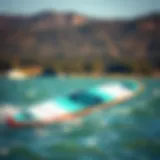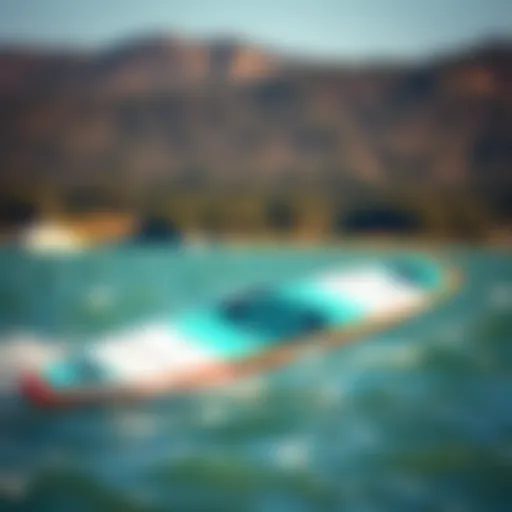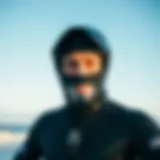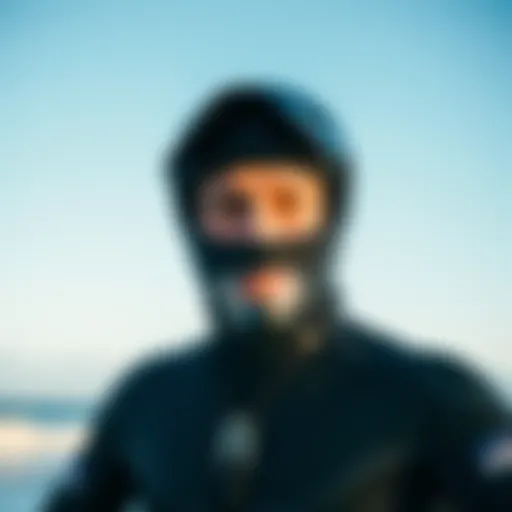Kitesurfing in the Outer Banks: Your Ultimate Guide
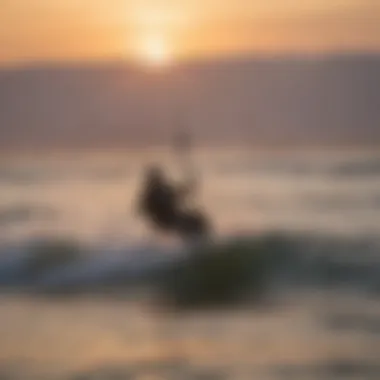

Intro
The Outer Banks, a string of barrier islands off the coast of North Carolina, is more than just a picturesque vacation spot; it’s a haven for adventurers and water sports enthusiasts. With wind conditions that could make even the most seasoned kiteboarders grin from ear to ear, this destination draws people from all walks of life. Kitesurfing here isn’t just a sport; it’s a way of life, a culture born from the need to ride the winds and waves in this coastal paradise.
At the heart of the Outer Banks’ appeal is its diverse range of kitesurfing locations, each offering a distinct experience. Whether you’re meandering through the tranquil waters of the Sound or tackling the more challenging surf breaks of the Atlantic Ocean, there’s a spot for everyone. This guide aims to navigate through the essential elements of kitesurfing in the Outer Banks, providing you not only with practical tips but also an insider’s look into the unique culture that kitesurfers share.
In the following sections, we will delve into gear insights, safety practices, and advanced techniques that can elevate your kitesurfing experience. Ready to catch some serious air? Let’s jump right in!
Gear Insights
Choosing the right gear is paramount to both your performance and enjoyment in kitesurfing. The gear you pick can significantly influence how you ride the waves. Here’s a closer look at the latest trends and beginner essentials to set you up for success in the Outer Banks.
Latest Gear Reviews
Keeping up with the swiftly changing world of kitesurfing gear can feel overwhelming. However, some items stand out due to their performance and user satisfaction. The Duotone Neo for instance, has reigned as a popular choice among enthusiasts for its versatility, making it suitable for both wave riding and freestyle tricks. Similarly, the Naish Pivot continues to impress with its quick turning and excellent upwind performance.
When it comes to kiteboards, the Slingshot Misfit is worth considering. It boasts a forgiving flex pattern, which is great for choppy conditions commonly found in the Outer Banks. Each piece of gear reflects the rider's personal style, so don’t hesitate to test different setups.
Essential Gear for Beginners
If you're just starting, it can feel daunting to understand what you absolutely need. To simplify, here’s a checklist that will help you get started:
- Kite: Choose a size based on your weight and local wind conditions. A smaller kite for high winds and a larger one for lighter winds.
- Control Bar: Look for something that feels comfortable in your hands. A basic safety system is crucial for any ride.
- Safety Harness: Make sure it fits tight but comfortably, as it's your connection to the kite.
- Board: Depending on your preference—twin-tip for versatility or directional for wave riding.
- Wetsuit: Essential for comfort in cooler waters, especially during spring and autumn.
- Impact Vest: For added protection, especially in rougher waters.
"Kitesurfing is not just about the wind and water; it’s about your gear's comfort and the skill to control it."
Techniques and Tips
Fine-tuning your technique is as important as having the right gear. Understanding the tricks of the trade will not only enhance your safety but also increase your enjoyment.
Advanced Tricks and Techniques
As you progress in kitesurfing, you may start dabbling in more advanced tricks. One popular maneuver is the hook pass, where you pass the handle behind your back. This trick can take some practice to master but adds flair to your riding. Another challenging yet rewarding trick is the kite loops, which involves pulling the kite down and back through the wind window for a rapid turn.
Safety Practices for Kiteboarders
Every adventure comes with its fair share of risks. Safety should always be at the forefront of any kiteboarding session. Here are a few practices to keep in mind:
- Always check the weather forecast before hitting the water. Wind speed and direction can change, so be prepared.
- Know the area where you plan to ride. Each spot has its own unique hazards.
- Stay hydrated and take breaks. Kiteboarding can be physically demanding.
- Practice self-rescue techniques to ensure you can handle unexpected situations.
Prologue to Kitesurfing in the Outer Banks
The Outer Banks, a chain of barrier islands off the coast of North Carolina, is not just a pretty face. It's a playground for water sports enthusiasts, especially if you take a liking to kitesurfing. This introduction sets the stage for why this region has become a go-to spot for kiteboarders of all skill levels.
Overview of the Outer Banks
Picture this: miles of sandy beaches, consistently strong winds, and shallow waters that stretch far out. The Outer Banks is blessed with geographical features that create perfect conditions for kitesurfing. The islands catch reliable winds coming off the Atlantic Ocean, making it an ideal locale for both casual adventurers and seasoned pros.
Each location within the Outer Banks brings its own charm. For example, Cape Hatteras offers expansive flat water and waves, attracting those who enjoy both styles of kitesurfing. Meanwhile, Kitty Hawk, the site of the Wright Brothers' first flight, combines friendly kiting spots with cultural significance.
Significance of Kitesurfing in the Region
Kitesurfing in the Outer Banks goes beyond just sport; it’s a deeply embedded part of the local culture and economy. This region has witnessed a surge in interest for kitesurfing, attracting a mix of hobbyists and serious athletes. Shops catering to this crowd flourish, and businesses thrive during the kiting season, which runs from spring through fall.
Moreover, kitesurfing encourages a sense of community. Local kitesurfers often gather to share tips, techniques, or simply stories of their adventures. Seasonal events and competitions draw in visitors and foster a spirit of camaraderie among both tourists and residents.
"Kitesurfing is not just a sport; it’s a lifestyle in the Outer Banks. The wind whispers, the waves cheer, and we respond with passion.”
This culture of participation and sharing becomes a vital thread in the fabric of life here in the Outer Banks. Whether you are a local or a visitor, the experience of kitesurfing connects everyone in a way that’s unique to this coastal haven.
Geographical Characteristics


Understanding the geographical characteristics of the Outer Banks is vital for grasping why this area has become a hotspot for kitesurfing. It’s not just about the wind and waves; the rhythm of the tides, and the unique layout of barriers and inlets, all play a role in creating ideal conditions for enthusiasts. This section delves into key factors like wind patterns, water types, and prime kiting locales that contribute to a remarkable kitesurfing experience.
Wind Patterns and Conditions
The Outer Banks has a treasure trove of wind patterns that shape the kitesurfing experience. The region benefits from both north-easterly and south-westerly winds, which typically blow consistently throughout the spring and fall months. These winds are not just random; they correlate with the shifting seasons, providing different strengths and angles that suit various skill levels.
For example, spring often sees less turbulent winds, making it more favorable for beginners looking to hone their skills. Conversely, seasoned kiteboarders might appreciate the stronger gusts that appear in the fall. The sheer predictability of these wind conditions allows for informed planning of kitesurfing sessions, giving riders a better shot at striking the sweet spot when conditions are just right.
Water Types and Features
Equally important is the variety of water types found here. The Outer Banks features both flatwater and wave riding conditions, catering to diverse preferences among kiteboarders. The sound-side waters are renowned for their shallow, flat water, which is immensely forgiving for beginners. On the flip side, the ocean-side boasts punchy waves that challenge advanced riders to exploit their skills.
In addition, tidal changes create a dynamic environment where the water depth fluctuates, inviting a different kind of excitement. Pockets of estuaries and marshlands provide sheltered areas that are ideal for practice, while open ocean spots bring forth a more thrilling adventure. This diversity fosters a rich playing field that can accommodate all sorts of kitesurfing styles, from freestyle to wave riding.
Key Locations for Kitesurfing
Cape Hatteras:
Cape Hatteras stands as a stalwart when it comes to kiting. Its broad, open beaches and steady winds make it a beloved spot for both novices and veterans alike. The area is not just about great conditions; it has a wide beach area that offers ample space to launch and land kites comfortably.
A key characteristic of Cape Hatteras is its famous "Hatteras Light," which not only serves as a local landmark but also as a navigational point for kitesurfers. Unique features like the expansive surf zone on the ocean side create opportunities for challenging wave riding that keeps the adrenaline flowing. However, the ocean's unpredictability can also be a double-edged sword, requiring a keen awareness of conditions for safety.
Kitty Hawk:
Kitty Hawk has its claim to fame as the birth of aviation, but it also plays a pivotal role in the kitesurfing scene. Known for its reliable winds, this location is particularly favored during the summer months. What makes it a standout for kiteboarding is the shallow waters near the shore that allow for freestyling and tricks without the fear of a deep water wipeout.
On the flip side, being a popular spot, it can get crowded, especially on weekends. This might detract from some riders' experience, but the local vibe and community spirit are undeniable draws. As a trade-off, riders learn to navigate their way around others, enhancing their skills in crowded conditions.
Rodanthe:
Rodanthe presents yet another enticing option with its laid-back atmosphere and strong winds. Welcome to a picturesque environment where undisturbed stretches of sand meet high waves. It is a gem for those who seek less-congested waters and a more relaxed vibe. The town’s natural charm makes it a pleasant retreat after a day on the water, and the stunning sunsets add icing on the cake.
The main catch is that Rodanthe often demands a good knowledge of kite control due to its strong ocean swells which can catch inexperienced riders off guard. Those who know what they're doing are in for a treat, but it’s incredibly important to respect the conditions and challenge oneself wisely.
In summary, the geographical characteristics of the Outer Banks represent a medley of favorable wind conditions, diverse water environments, and key locations that together form an enchanting playground for kitesurfers. Knowing this landscape can set the stage for unforgettable experiences, ensuring that every ride is as thrilling as the last.
Essential Gear for Kitesurfing
Investing in the right gear can make or break your kitesurfing experience in the Outer Banks. The right equipment not only enhances performance but also ensures safety, making the adventure as enjoyable as possible. Each piece of gear serves a unique function, tailored to specific conditions and riders' needs. Understanding the nuances of kites, boards, and safety equipment is essential for both new and experienced enthusiasts.
Kite Selection: Types and Sizes
When deciding on a kite, the choices can be as vast as the ocean itself. Kites generally fall into two main categories: inflatable kites and hybrid kites. Inflatable kites are often the go-to for beginners. They’re forgiving and have a larger wind range. Hybrid kites, on the other hand, can be trickier but offer more agility and speed. Size also plays a crucial role; smaller kites perform better in strong winds, while larger ones are ideal for lighter air. Beginners should consider starting with a kite in the size range of 9 to 12 meters, allowing for a good balance between maneuverability and lift.
Board Options and Suitability
Just like the kite, choosing the right board is vital. Board types vary widely, from twin tips to surfboards, and each offers a different riding experience. Twin tip boards are often favored by freestylers and beginners alike for their versatility; they can be ridden in both directions. Surfboards cater more to wave riding and offer a different feel when carving through water. It's important to match the board size to your weight and skill level. For instance, a heavier rider might benefit from a larger board for better floatation, while a lighter rider might prefer something smaller for easier handling in the water.
Safety Equipment: What You Need
Safety equipment is essential and not to be overlooked. The right gear not only protects you, but also provides peace of mind as you navigate through the waves.
Impact Vest
An impact vest adds a layer of protection against falls, which are common in kitesurfing. It not only cushions the body during hard landings but also provides buoyancy, which can help prevent drowning in case of an unexpected spill. A good impact vest is both snug and comfortable, allowing for movement without restriction. Some even come with built-in flotation devices, enhancing safety without sacrificing comfort during long sessions on the water.
Helmet
A helmet is a must-have, especially in busy waters or during tricks. It protects your head from collisions whether with the board or other objects. Look for helmets with a snug fit and reliable chin straps. Many come with ventilation holes to keep your head cool while riding. Although you might wonder if it's overkill, it’s a simple measure that can make a significant difference in preventing injuries. Safety should always be a priority; no one wants to cut their adventure short due to an avoidable accident.
Safety Leash
A safety leash connects you to your board, ensuring it doesn't drift away after a wipeout. This piece of gear also enhances safety by preventing unwanted tangles, which can be quite dangerous in turbulent waters. When selecting a leash, focus on durability and length. A longer leash might give you more freedom, but it can also increase the risk of collisions. Finding the right balance is key—opt for one that enables a safe distance without compromising your ability to control your gear.


The right gear enhances your experience. Don’t count safety equipment as optional; it's essential for enjoyment and peace of mind in the thrill of kitesurfing.
Kitesurfing in the Outer Banks is an exhilarating adventure. Equipping yourself with the right gear ensures that you enjoy every moment on the water while prioritizing safety. With knowledge about kite selection, board suitability, and essential safety gear, you're on the right path to a memorable kitesurfing experience.
Safeguarding Your Experience
Kitesurfing is an exhilarating sport that attracts thrill-seekers all over the world, and the Outer Banks stands out as a prime destination. However, to truly enjoy this adventure, understanding how to safeguard your experience is essential. This does not only enhance your enjoyment but ensures you remain safe while navigating the winds and waters.
Understanding Wind and Water Safety
Playing with the elements, kitesurfing demands respect for both wind and water. Being aware of the conditions can mean the difference between a thrilling experience and a hazardous one. First off, always check local weather forecasts before heading out. Many kitesurfers have their stories of unexpected weather shifts, so arm yourself with knowledge.
Wind patterns in the Outer Banks can be unpredictable. The best way to understand these patterns is to observe them yourself during different times of the day. Lighter winds may accompany calm mornings, while afternoons can bring stronger gusts.
Regarding water, familiarizing yourself with tides is equally critical. Higher tides can drown out certain areas, making launching and landing problematic. Plus, shallow waters can present their own dangers, like sudden sandbars. Always be aware of your surroundings.
"Knowledge is power, especially when you’re riding on water and pulled by a kite!"
Local Regulations and Etiquette
Navigating the kitesurfing scene isn't just about the gear and conditions; it’s also about community and compliance. Each area in the Outer Banks has its own set of regulations regarding kitesurfing. Ignoring these can lead to fines or safety issues. Common rules often include restrictions on specific spots for certain activities, especially crowded beaches or fishing areas.
Moreover, understanding etiquette can vastly improve your experience and build harmony within the kitesurfing community. Always give right of way to those launching or landing their kites, and be mindful of space. It’s not just about having fun; it’s about sharing the water respectfully.
To help you navigate local regulations, consider becoming familiar with community boards or online forums. Committing to understanding these guidelines not only keeps you informed but also makes you a better ambassador for the sport.
Emergency Protocols to Consider
As exhilarating as kitesurfing is, accidents can happen. Being prepared with emergency protocols could be your lifesaver—literally. Before stepping onto your board, have a plan.
- Know How to Communicate: Carry a waterproof radio or familiarize yourself with local distress signals. Communication is critical if something goes awry.
- Identify Landmarks: While out on the water, know where you are and have a plan to return if the winds shift.
- Buddy System: Whenever possible, kite with a partner. Not only is it more fun, but you can watch each other’s backs.
- First-Aid Gear: Consider packing a basic first aid kit. While you might not have specific items tailored for kitesurfing, something as simple as band-aids or antiseptic wipes can come in handy.
By keeping safety at the forefront, you can focus on the enjoyment of kitesurfing, making thrilling memories without the shadow of danger looming overhead.
Local Instruction and Training
The journey into kitesurfing can often feel like a thrilling roller coaster, especially for beginners venturing into a new realm of adventure. That's where local instruction and training come into play, acting as the guiding hand that can make all the difference. Keen to harness the wind and water safely? Tapping into the expertise of seasoned instructors is invaluable. They not only impart technical skills but also instill confidence, ensuring learners are equipped with knowledge about equipment and environmental conditions.
Finding Skilled Instructors
When it comes to selecting a competent instructor, the criteria can be as varied as the winds that shape the Outer Banks. Look for instructors who are certified through recognized organizations, like the International Kiteboarding Organization (IKO) or the British Kitesports Association (BKSA). These credentials signify a standard of training that prioritizes safety and technique. Additionally, consider the instructor's experience level and local knowledge, as familiarity with the Outer Banks' unique conditions is essential.
Networking through online kitesurfing communities, such as forums on Reddit or Facebook groups, can lead to personal recommendations. Word-of-mouth often reflects the quality of instruction available. It’s not just about teaching; it’s about connecting with someone passionate about the sport and eager to share their knowledge.
Beginner Courses and Progression
For those just dipping their toes into the world of kitesurfing, enrolling in a structured beginner course can pave the way forward. Courses typically cover the fundamentals: understanding gear, wind patterns, and safety protocols. A solid foundation is critical for building skills progressively. Look for courses that offer hands-on experience—water time is where the real learning happens.
As you advance, instructors often incorporate techniques such as body dragging and water starts. These elements are crucial not only for improving your skills but for acquiring the necessary confidence to tackle more challenging conditions. Tracking your progress in a course can help keep motivation high and ensure safety, preventing the excitement from turning into a dangerous endeavor.
Advanced Techniques and Tips
Once you’ve mastered the basics, the world of advanced kitesurfing techniques awaits. Some kiteboarders crave the thrill of tricks and aerial maneuvers. Focus on building solid riding skills first, as they form the backbone for complex tricks. Smooth transitions and edge control play a vital role in executing jumps or spins gracefully.
Furthermore, being part of local kitesurfing events can surrogate learning through observation and practice with peers. Observing better riders can spark inspiration while learning from their techniques. Seek feedback from instructors or fellow kiteboarders after attempting new tricks or maneuvers—constructive criticism is essential for improvement.
In this sport, it’s essential to stay updated on equipment advancements and safety practices. Join community discussions, perhaps on platforms like Facebook or Reddit, to share experiences or gather tips. The kitesurfing culture thrives on shared knowledge, creating a close-knit community eager to help one another succeed.
"Kitesurfing is not just a sport; it’s a lifestyle—one that embraces both the challenge and joy of riding the wind."
In summary, local instruction and training form the crux of mastering kitesurfing in the Outer Banks. With skilled instructors guiding the way and structured courses paving the path, anyone can transform from a hesitant novice to a confident rider ready to take on the waves.
Cultural Context of Kitesurfing


The cultural aspect of kitesurfing in the Outer Banks is as dynamic as the sport itself. It involves a vibrant community of enthusiasts, a plethora of events that unite riders, and a complex interrelationship between tourism and local culture. Understanding this cultural context not only enhances the experience for participants but also fosters a sense of belonging among kitesurfers of all skill levels. The Outer Banks has become a melting pot for different riding styles, showcasing a blend of amateur passion and competitive spirit that exists side by side.
Community Engagement and Events
Kitesurfing brings people together; it’s more than just a sport—it's about connections. The Outer Banks hosts numerous local events that celebrate this adrenaline-fueled activity. From friendly competitions to informal meet-ups, these gatherings build camaraderie among riders. Festivals like the Hatteras Island Kitesurfing Tournament are pivotal in attracting talent from beyond the region, allowing local riders to showcase their skills while also learning from seasoned pros.
Moreover, community involvement often extends beyond just kitesurfing. Local shops frequently organize beach clean-ups, fostering a connection between the sport and environmental stewardship. This sense of responsibility to protect the beautiful landscapes that host their beloved kitesurfing is a thread that binds the community together.
Interviews with Local Enthusiasts
To truly understand the essence of kitesurfing in the Outer Banks, insights from local riders are invaluable. Conducting interviews with these passionate individuals sheds light on their personal journeys, motivations, and the peculiarities of riding in this region.
For example, a long-time kitesurfer may share how they navigated the unpredictable wind patterns or the local secrets of choosing the best launch spots year-round. Insights like this are golden for newcomers looking to deepen their understanding of both the sport and the local landscape. These conversations highlight a common theme: a deep appreciation for the area’s natural beauty, along with a commitment to nurturing the sport and community.
Impact of Tourism on Kitesurfing
Tourism plays a significant role in shaping the kitesurfing landscape of the Outer Banks. As more visitors flock to the region, many are eager to try their hand at kitesurfing, driving the demand for local schools and gear rental shops. This influx benefits local economies, providing opportunities for businesses that cater specifically to thrill-seekers.
However, this growth isn't without challenges. Increased foot traffic can lead to congestion at popular spots, affecting the riding experience. Local regulations often adapt to address these changes, aiming to balance the needs of tourists and the established kitesurfing community. The consensus among locals is that while tourism brings opportunity, it also necessitates a collective effort to preserve the integrity of the sport.
"Kitesurfing isn't just about the wind and waves; it’s about the community that rides them. Embrace it, and the sport embraces you back."
In summary, the cultural context of kitesurfing in the Outer Banks is multifaceted, driven by community engagement, shared experiences, and the impact of tourism. By grasping these elements, participants can enrich their kitesurfing journey, fostering connections that extend beyond the shore.
Optimal Timing for Kitesurfing
Kitesurfing in the Outer Banks isn't just about strapping on your gear and hitting the waves whenever you feel like it; timing is everything. Understanding the best windows of opportunity not only can elevate your experience but also enhances your safety and enjoyment. A keen awareness of seasonal trends, weather variations, and crowd patterns can be the difference between a fantastic outing and a frustrating day on the water. Let's break down the details that make optimal timing a priority.
Seasonal Trends and Patterns
The seasons in the Outer Banks shape the kitesurfing landscape significantly. Generally, the peak kiting conditions occur during late spring to early fall. During this time, steady winds blow, and the water is pleasantly warm, making it ideal for kitesurfing.
- Spring (April to June): Winds start to pick up, typically ranging from 15 to 25 knots. This season marks the transition into the warmer months, where you can find good conditions without the summer crowds.
- Summer (July to August): The Outer Banks shines with a mix of consistent winds and warm waters, drawing many enthusiasts. However, this period not only means great winds but also heavier crowds. Expect larger gatherings at popular kiting spots.
- Fall (September to November): Winds in the fall are often brisk and reliable, perfect for impressing your friends with new maneuvers. Plus, as tourists dwindle, you can enjoy the serenity of the coast.
- Winter (December to March): Although the winds can still be good, the colder temperatures might not be inviting for everyone. Those who brave the chill often have the beaches to themselves, but conditions can be unpredictable, so check forecasts closely.
Weather Considerations Throughout the Year
Weather is a fickle friend when it comes to kitesurfing. Beyond seasonality, monitoring daily conditions plays a crucial role. Look to the wind direction, consistency, and strength, as these factors vary.
- Wind Direction: For optimal conditions, a side-onshore wind is preferable. It allows for easy access and retrieval, keeping you safe and enjoying.
- Wind Strength: Generally, a consistent wind speed of 12-25 knots is ideal for most riders. Lower or substantially higher winds can make kiting less enjoyable or dangerous. Kitesurfers must be aware of their equipment’s specific needs, as different kites perform variably based on the wind.
- Weather Alerts: Keep an eye on local forecasts through trusted sources. Sudden weather changes can turn a sunny day into a stormy one—and that’s the last thing you want while kiting.
Balancing Crowds and Conditions
During the busy summer months, balancing the joy of kitesurfing with crowded conditions is essential. Popular spots like Cape Hatteras and Kitty Hawk can become bustling hubs, especially during weekends and holidays. Here’s how to navigate the madness:
- Go Early or Late: Early mornings or late afternoons often provide both calm waters and fewer crowds, giving you space to work on your skills without the pressure of dodging other surfers.
- Explore Less Commercialized Areas: While the well-known locations are popular for a reason, venturing to less crowded beaches may enhance your kitesurfing experience. The thrill of discovery adds fun to the sport.
- Plan Accordingly: If you're itching to hit the waves during peak times, arriving just a tad earlier than others can secure you a good spot on the beach. Plus, setup time becomes a breeze when you’re not rushed.
"Timing in kitesurfing is like the wind itself; you can’t control it, but you can learn to ride it."
The End: The Appeal of Kitesurfing in the Outer Banks
Kitesurfing in the Outer Banks isn’t just a sport; it’s an experience that combines the thrill of adventure with the serenity of nature. The region stands out due to its unique geographical features, creating perfect winds and waters that cater to both beginners and seasoned pros. It's crucial to appreciate the diversity of spots available, each offering distinct challenges and experiences that keep kiteboarders coming back for more. This guide not only highlights the necessary preparations but also emphasizes the rich culture surrounding this popular activity.
The allure of these windswept shores is about soaking up the sun, the wind in your hair, and the water beneath your board. For anyone considering a trip, understanding these key elements can make or break your experience.
Summarizing the Key Aspects
Before packing up that gear, it's worth reiterating some key points:
- Ideal Locations: Spots like Cape Hatteras and Kitty Hawk provide optimal conditions for kitesurfing year-round. Each locale has a personality of its own.
- Essential Gear: The right equipment tailored to individual skill levels can enhance safety and performance. Knowledge of kites and boards, paired with safety equipment, ensures a worry-free ride.
- Seasonal Insights: Timing is everything in this game. Wind patterns shift with the seasons, making certain times more favorable for kitesurfing.
- Community Vibe: Engaging with local enthusiasts and instructors through community events enriches the overall experience and fosters connections.
Kitesurfing in the Outer Banks thrives on this blend of adventure, camaraderie, and natural beauty, making it a rewarding endeavor.
Encouraging Enthusiasts to Explore
For those who feel the tug of the wind and the call of the waves, the Outer Banks offers an invitation like no other. Whether you're a curious novice or a seasoned kiteboarder, the possibilities for exploration are endless.
- Try New Spots: Don't shy away from venturing to lesser-known beaches. Each section of the Outer Banks has something unique to offer, from flat waters to challenging swells.
- Take Lessons: New to the game? Local instructors are eager to help you get started on the right foot. Learning from those who know the area ensures you grasp essential safety and technique from the get-go.
- Join Events and Meet-Ups: Participate in local kitesurfing events or friendly meet-ups. It’s a great way to connect with others in the sport, share experiences, and even pick up tips from seasoned riders.
Remember, the Outer Banks is more than just a place to kiteboard; it's a community that embraces adventure. The wind and the waves are calling—are you ready to answer?






